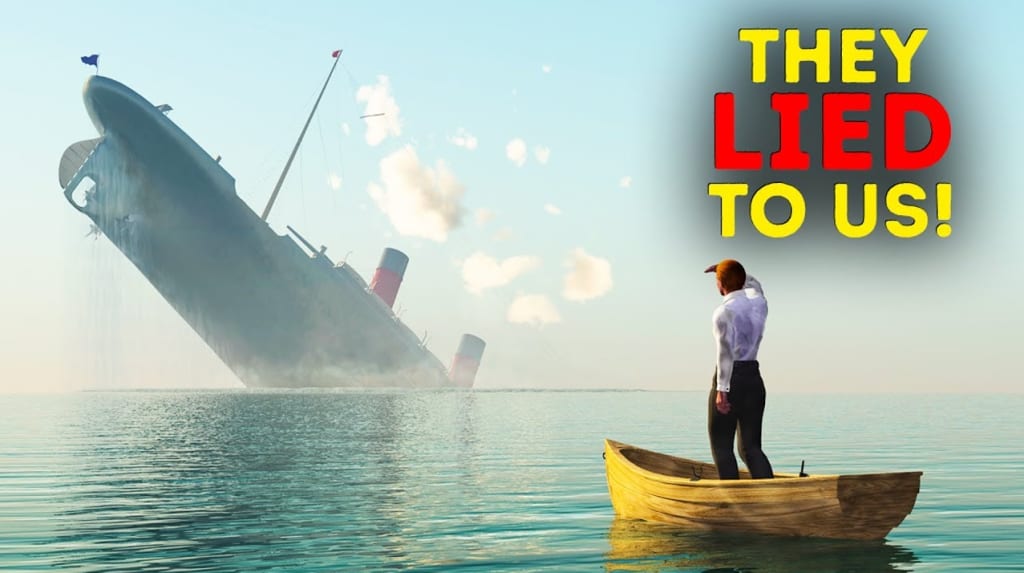The Truth About the Titanic Has Been Revealed
The Truth Unveiled: Debunking the Titanic Myths

Debunking the Iceberg Theory and Exploring the Role of Fire
On the fateful night of April 14th, 1912, at 11:40 p.m., the RMS Titanic, the largest ship of its time, encountered a horrific accident that would lead to its ultimate demise. Three hours later, by 2:20 a.m. on April 15th, in the early morning darkness, the Titanic disappeared completely beneath the ice-cold surface of the Atlantic Ocean. This tragic event claimed the lives of over 1,500 individuals, accounting for more than two-thirds of all the people on board. While it has been widely believed that the collision with an iceberg was the cause of this devastating disaster, recent findings from scientists challenge this theory. In this video, we will delve into the hidden truth that has remained buried for over a century.
The Construction of the Titanic: A Monumental Feat
The Titanic was an engineering marvel, measuring 882 feet 9 inches in length, 92 feet wide, and 175 feet tall, with a usable volume of 46,000 328 tons. It appeared indestructible, and its vast expanse offered countless passages and decks for people to explore. Even the ship's officers required over two weeks to familiarize themselves with its immense layout. The Titanic boasted four massive smokestacks, each weighing 60 tons and extending 81.5 feet above the deck. These smokestacks were angled at 30 degrees to create an even more impressive and imposing appearance. The construction of this magnificent vessel came with a staggering cost of 7.5 million dollars, equivalent to approximately 166 million dollars in today's currency, considering inflation and exchange rates. Surprisingly, this amount was still less than the production cost of the renowned 1997 film "Titanic," which amounted to 200 million dollars.
Harland and Wolff shipyard employed a workforce of 3,000 men to bring the Titanic to life. Despite their collective efforts, it took 26 months of grueling labor, six days a week from 6:00 in the morning, to complete this monumental task. The construction process was arduous and perilous, with workers toiling at heights equivalent to a 20-story building, without the safety of ropes. However, their motivation stemmed from the need to support their families. These builders received a weekly wage of 2 pounds, which might not seem substantial by today's standards, but it was a competitive salary at that time. Unfortunately, eight lives were lost, and 246 individuals sustained injuries during the construction process. It is unfathomable that a complex masterpiece, built with tremendous effort, resources, and money, could meet such a tragic end.
Fated Journey: Negligence and Missed Opportunities
For years, it was believed that the Titanic's collision with an iceberg was the primary cause of its sinking. However, journalist Sonam Maloney, who dedicated over three decades to studying the Titanic's fate, made a groundbreaking discovery. He stumbled upon a previously unpublished photograph showing a massive 30-foot-long black spot on the ship's hull. This blackened area indicated a fire that had been burning at an intense temperature for approximately three weeks, significantly weakening the metal structure. Metallurgy experts confirm that under such conditions, the metal's strength could have been reduced by up to 75 percent. Consequently, when the iceberg struck, it easily tore a hole in the compromised side of the ship. Thus, new findings challenge the long-held iceberg theory and suggest that fire played a crucial role in the catastrophe.
Interestingly, the management of the Titanic project was aware of the fire and the potential risks associated with embarking on the ill-fated voyage. However, acknowledging the situation would have meant financial ruin for the ship's owners. At that time, coal miners across the country were on strike, resulting in a shortage of coal to sustain the Titanic. Despite this predicament, tickets had already been sold, and other ships had been canceled as passengers clamored to experience the grandeur of the largest ship in the world. In an attempt to conceal the truth, the ship was turned in a way that kept the marks from the fire hidden from view, facing away from the docks toward the sea. The unsuspecting passengers remained unaware of the danger lurking beneath the surface.
Luxurious Amenities and Astonishing Oversights on Board
The interior of the Titanic was a testament to opulence and luxury, inspired by the grandeur of the Ritz Hotel in London. The grand staircase spanned seven out of the ship's ten decks, adorned with paintings, bronze cherubs, and oak paneling. First-class passengers enjoyed lavish facilities, including a swimming pool with heated water, a Turkish bath, a gym, a squash court, and even a beauty salon. For the ladies, there were stylists available to assist them in preparing for dinner. The ship even had its own onboard newspaper, the Atlantic Daily Bulletin. Remarkably, there was a designated area on board for first-class passengers' dogs, who were cared for, taken for walks, and could receive training during the voyage. The dining experience for first-class passengers was a grand affair, consisting of 13 courses, each paired with its own wine. The banquet would last approximately five hours, with an abundance of 1,500 bottles of wine, 20,000 bottles of beer, and 8,000 cigars. However, despite the ship's luxurious amenities, a surprising oversight was the absence of binoculars on board, which could have potentially aided in detecting the looming iceberg.
The Perilous Night and Unnoticed Distress Signals
As the Titanic sailed into the night, it faced numerous perils that would contribute to its tragic fate. First and foremost, the ship was pushing its speed limit, driven by the pressure to maintain its schedule and uphold the Titanic's prestigious reputation. This decision to travel at an accelerated pace significantly reduced the time available to react to potential hazards. Furthermore, the number of lifeboats on board was grossly inadequate. While the chief designer initially planned for 48 lifeboats, the final count was reduced to a mere 20, primarily for cosmetic reasons. This meant that the lifeboats could only accommodate one-third of the total passengers on board, a staggering oversight considering the ship's capacity.
Additionally, the lack of proper safety drills on the Titanic further compounded the tragedy. Captain Edward John Smith canceled a scheduled lifeboat drill that was supposed to take place on the day of the collision. Passengers and crew members were thus ill-prepared for the chaos and confusion that ensued when the ship struck the iceberg. The absence of a practiced evacuation plan resulted in panic, further hindering the chances of a successful rescue operation.
Moreover, the distress signals sent out by the Titanic went largely unnoticed or dismissed by other ships in the vicinity. The nearby vessel, the SS Californian, was just ten miles away from the sinking Titanic but failed to respond to the distress calls. The radio operator on board the Californian had turned off the wireless system for the night, oblivious to the disaster unfolding nearby. This missed opportunity for assistance would haunt the survivors and investigators alike.
The Legacy and Lessons Learned from the Titanic Tragedy
The sinking of the Titanic sent shockwaves around the world and sparked significant changes in maritime safety regulations. In the aftermath of the disaster, the International Convention for the Safety of Life at Sea (SOLAS) was established to ensure the safety of ships and passengers at sea. This treaty mandated improvements such as increasing the number of lifeboats and providing regular safety drills. Additionally, the tragedy emphasized the importance of effective communication and coordination during maritime emergencies, leading to advancements in radio communication protocols and the establishment of dedicated distress frequencies.
The story of the Titanic serves as a reminder of the consequences of negligence, complacency, and the prioritization of luxury over safety. It stands as a symbol of human hubris and the need for continuous vigilance in the face of potential disasters. The lessons learned from the Titanic continue to resonate today, influencing the design and operation of modern ships and reinforcing the commitment to passenger safety above all else.
In conclusion, the untold story of the Titanic reveals a more complex narrative than previously believed. The presence of a fire weakening the ship's hull, the negligence and missed opportunities, and the luxurious amenities overshadowed by critical oversights all played significant roles in the tragedy. The legacy of the Titanic serves as a stark reminder of the importance of thorough preparation, responsible decision-making, and unwavering dedication to the safety of those on board. May the memory of those lost aboard the Titanic forever remind us of the price we pay for hubris and the ongoing pursuit of safer seas.
About the Creator
Max Carter
Hello there! My name is Max Carter, and I am a professional writer and creator of stories for kids. I have always had a passion for writing, and I have been fortunate enough to turn that passion into a career.






Comments
There are no comments for this story
Be the first to respond and start the conversation.